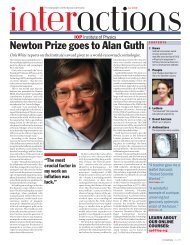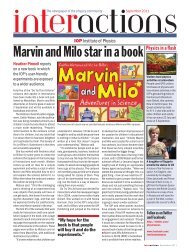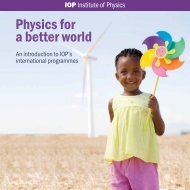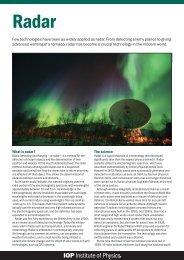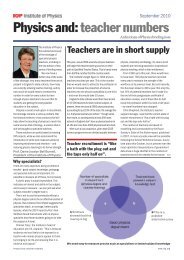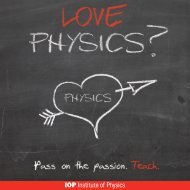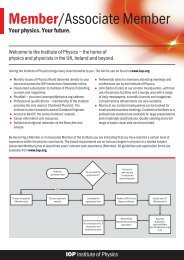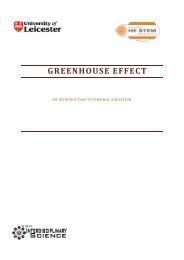Girls in the Physics Classroom: A Teachers' Guide - Institute of Physics
Girls in the Physics Classroom: A Teachers' Guide - Institute of Physics
Girls in the Physics Classroom: A Teachers' Guide - Institute of Physics
You also want an ePaper? Increase the reach of your titles
YUMPU automatically turns print PDFs into web optimized ePapers that Google loves.
1: Lessons from effective classroom practice<br />
5. In a Class <strong>of</strong> Their Own?<br />
Teach<strong>in</strong>g science <strong>in</strong> s<strong>in</strong>gle-sex<br />
classes <strong>in</strong> co-educational schools<br />
– a guide to good practice (2004)<br />
WISE.<br />
6<br />
In a mixed comprehensive school for 11–18-year-olds<br />
has moved away from modular Double Award Science to<br />
improve cont<strong>in</strong>uity. It now has specialist teach<strong>in</strong>g for <strong>the</strong><br />
biology, chemistry and physics components <strong>of</strong> a Double<br />
Award course. Teachers commented: “We felt that we<br />
were mak<strong>in</strong>g pupils jump through hoops at regular<br />
<strong>in</strong>tervals ra<strong>the</strong>r than develop<strong>in</strong>g key ideas <strong>in</strong> <strong>the</strong><br />
discipl<strong>in</strong>es over time.” School-developed resources and<br />
l<strong>in</strong>ks to websites are available for each topic on <strong>the</strong><br />
school website and pupils are encouraged to review<br />
certa<strong>in</strong> areas before start<strong>in</strong>g a new unit. So far pupils<br />
have done just as well at GCSE as previously and take-up<br />
<strong>of</strong> sciences <strong>in</strong> general and physics <strong>in</strong> particular has<br />
improved. More girls are tak<strong>in</strong>g physics.<br />
Messages for practice<br />
● Avoid fragment<strong>in</strong>g <strong>the</strong> pre-16 science curriculum more<br />
than absolutely necessary; plan to make explicit l<strong>in</strong>ks<br />
between related areas. The use <strong>of</strong> “m<strong>in</strong>d/concept<br />
maps” or group preparation <strong>of</strong> displays summaris<strong>in</strong>g a<br />
topic may be a useful approach.<br />
● Give weight to cont<strong>in</strong>uity <strong>of</strong> specialist teach<strong>in</strong>g when<br />
timetabl<strong>in</strong>g. If possible, enable pupils to experience<br />
<strong>the</strong> teach<strong>in</strong>g style that is likely to be used post-16.<br />
1.3 <strong>Classroom</strong> organisation and<br />
management<br />
How can teachers vary <strong>the</strong>ir classroom organisation to<br />
encourage full participation by girls <strong>in</strong> physics?<br />
The recently published guide In a class <strong>of</strong> <strong>the</strong>ir own 5<br />
describes how some coeducational schools have created<br />
s<strong>in</strong>gle-gender groups for <strong>the</strong> teach<strong>in</strong>g <strong>of</strong> science. None <strong>of</strong><br />
<strong>the</strong> mixed schools visited as part <strong>of</strong> this survey had formed<br />
such groups but many <strong>of</strong> <strong>the</strong>m employed a variety <strong>of</strong> group<strong>in</strong>g<br />
strategies for different classroom activities.<br />
Some schools <strong>of</strong>ten organised pupils <strong>in</strong>to s<strong>in</strong>gle-gender<br />
groups for practical work. Teachers found that, <strong>in</strong> mixed<br />
groups, boys tended to rush <strong>in</strong>to practical activity while girls<br />
<strong>of</strong>ten wanted to draw up tables for results or carry out o<strong>the</strong>r<br />
preparatory work before start<strong>in</strong>g an experiment. This led to<br />
a polarisation <strong>of</strong> roles, with boys becom<strong>in</strong>g <strong>the</strong> “doers” and<br />
girls becom<strong>in</strong>g <strong>the</strong> “scribes”. A typical comment was:<br />
“We like to th<strong>in</strong>k th<strong>in</strong>gs through and know what<br />
we’ve got to do. Boys just jump <strong>in</strong> and don’t<br />
seem to worry if <strong>the</strong>y get it wrong.”<br />
S<strong>in</strong>gle-sex practical groups <strong>in</strong> schools that projected a<br />
can-do approach helped to improve <strong>in</strong>volvement by girls <strong>in</strong><br />
“hands-on” practical activities. However, even <strong>in</strong> <strong>the</strong> s<strong>in</strong>gle-sex<br />
groups, students rapidly adopted narrow roles. One<br />
school overcame this problem by assign<strong>in</strong>g tasks to different<br />
students <strong>in</strong> a group on rotation.<br />
Some <strong>of</strong> <strong>the</strong> most successful lessons observed <strong>in</strong>cluded<br />
small-group activities, such as <strong>the</strong> discussion <strong>of</strong> an issue<br />
or <strong>the</strong> preparation <strong>of</strong> a presentation or some display materials.<br />
These approaches were generally popular with girls,<br />
particularly when <strong>the</strong>y were work<strong>in</strong>g <strong>in</strong> s<strong>in</strong>gle-sex groups.<br />
In <strong>the</strong>se situations, girls <strong>of</strong>ten displayed superior organisational<br />
skills to boys and divided up tasks <strong>in</strong> a systematic<br />
way. Tangible outcomes, such as display materials, were<br />
<strong>of</strong> high quality <strong>in</strong> content as well as presentation, and <strong>the</strong>se<br />
<strong>of</strong>ten helped girls to articulate <strong>the</strong>ir understand<strong>in</strong>g.<br />
Several teachers dist<strong>in</strong>guished between social and work<strong>in</strong>g<br />
groups. Pupils were usually allowed to sit with o<strong>the</strong>r students<br />
<strong>of</strong> <strong>the</strong>ir own choos<strong>in</strong>g but <strong>the</strong>y were expected to work<br />
<strong>in</strong> different comb<strong>in</strong>ations depend<strong>in</strong>g on <strong>the</strong> activity. Once<br />
established, this approach was not questioned by pupils<br />
and it ensured that each <strong>of</strong> <strong>the</strong>m adopted a variety <strong>of</strong> roles<br />
over time. <strong>Girls</strong>, <strong>in</strong> particular, were pleased to be freed from<br />
<strong>the</strong> role <strong>of</strong> record<strong>in</strong>g and note-tak<strong>in</strong>g. Vary<strong>in</strong>g <strong>the</strong> group<strong>in</strong>gs<br />
<strong>in</strong> which students worked also enabled <strong>the</strong> teachers to<br />
emphasise <strong>the</strong> co-operative nature <strong>of</strong> physics, debunk<strong>in</strong>g<br />
<strong>the</strong> view that physics is always a solitary activity.<br />
Pupils are grouped differently depend<strong>in</strong>g on <strong>the</strong><br />
activity. Discussion groups are s<strong>in</strong>gle gender but followed<br />
by whole-class plenary. Practical groups change and<br />
<strong>in</strong>dividuals are nom<strong>in</strong>ated to report back f<strong>in</strong>d<strong>in</strong>gs. In this<br />
way <strong>the</strong>re are no passengers –all pupils play an active<br />
part yet none can dom<strong>in</strong>ate. <strong>Girls</strong> hold <strong>the</strong>ir own and are<br />
not overshadowed by a small number <strong>of</strong> vocal boys.<br />
Messages for practice<br />
● Dist<strong>in</strong>guish between social (seat<strong>in</strong>g) groups and<br />
work<strong>in</strong>g groups and change <strong>the</strong> latter periodically.<br />
● Try out different group<strong>in</strong>gs for most practical work and<br />
discussion, perhaps <strong>in</strong>clud<strong>in</strong>g s<strong>in</strong>gle-sex groups as<br />
part <strong>of</strong> an overall strategy for improv<strong>in</strong>g <strong>the</strong><br />
participation <strong>of</strong> girls.<br />
● Ensure that all girls play an active part <strong>in</strong> activities and<br />
do not just act as note-takers.<br />
● Group students accord<strong>in</strong>g to <strong>the</strong>ir learn<strong>in</strong>g needs and<br />
aptitudes not for classroom control.<br />
1.4 Questions and answers<br />
How can teachers frame and address questions <strong>in</strong><br />
ways that will encourage girls to respond and to<br />
articulate <strong>the</strong>ir understand<strong>in</strong>g and concerns?<br />
The question<strong>in</strong>g technique that teachers use is a crucial<br />
factor <strong>in</strong> engag<strong>in</strong>g girls <strong>in</strong> physics. In a mixed class, boys<br />
will almost always be <strong>the</strong> first to respond to a request for<br />
“hands up” to answer a question directed at <strong>the</strong> whole<br />
class. Very few <strong>of</strong> <strong>the</strong> teachers who participated <strong>in</strong> this project<br />
used this approach because <strong>the</strong>y were well aware that<br />
girls would be less likely to contribute. By allow<strong>in</strong>g th<strong>in</strong>k<strong>in</strong>g<br />
time, most <strong>of</strong> <strong>the</strong> teachers also avoided <strong>in</strong>stant responses,<br />
which typically came from boys and denied o<strong>the</strong>r students<br />
<strong>the</strong> opportunity to reach an answer.<br />
“A hand up means that someone wants to ask a<br />
question. I use o<strong>the</strong>r ways – such as<br />
whiteboards – to f<strong>in</strong>d out who can remember<br />
someth<strong>in</strong>g. I ask fewer questions and allow<br />
I NSTITUTE OF P HYSICS R EPORT G IRLS IN THE P HYSICS C LASSROOM: A TEACHERS’ GUIDE FOR A CTION D ECEMBER 2006





